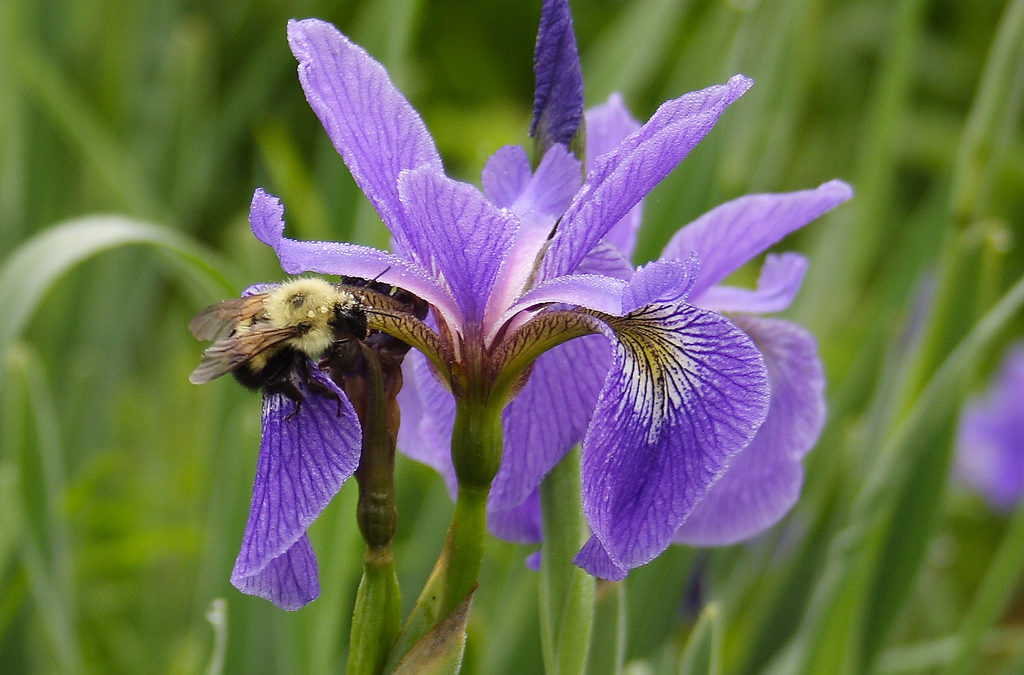I always wanted to make a nature crayon series. The array of hues that color our world is inspiring and perhaps infinite. Often we don’t realize that, or even teach it. I hear myself saying as I teach kids “What colors can you see in that?” and their answers are red, blue, green, yellow, or another of the ROY G BIV spectrum learned early in life. Interestingly, indigo and violet are rarely spoken, instead they morph into a hybrid called purple.
List something that is purple. Immediately to mind come grapes, iris, violets, and the purple people-eater. Later my brain reaches for amethyst gems, sage and lavender flowers. Deeper I dig and come up with a dusk sky, the tips the grasses that flower in early June, and the inside of the shells found along the seashore. None of those purples are the same, and yet they are all purple.

Purple Clover by Jennifer Schlick
Technically, purple and violet are different, the latter having a specific wavelength and so its own “color” whereas the former is a combination of red
and blue and so a composite. Violet is a little closer to blue and purple a lit bit closer to red. And if you go to a different country it might look different yet. Perhaps not much, but enough.
Subtlety in nature makes it profound. And purple is a rich color. Often symbolizing royalty, richness, magic, or piety purple has been in use for thousands of years. It is also ambiguous, neither red nor blue, but both or neither lending itself well to all messages but especially those of unconventional nature, or unnoticed.
Purple is the color of your fingers after picking blackberries and blueberries. It becomes the pigment of a rich summer bounty, the color of plenty. Berry Stain would be the name of the crayon. Purple is the color of a new spruce or tamarack cone, the stem of the pokeweed, and New England Asters that blanket the countryside come autumn. Purple is the color of the leaves of the tree I grew up under. It is the tint of the backdrop of hours of outdoor play that set deep within me a seed of passion. The color purple connected me to the earth. That crayon might just be called Beech Home Purple.
In the midst of writing this article I went for a walk. I was showing a schoolyard to one of the interns in preparation for schoolyard field trips. On the ground in the weeds was a Luna Moth. The ephemeral pale green of the delicate wings is its defining characteristic. But the leading edge of those as well as the furred feet of the giant moth are, as you may expect at this point, purple. I may have seen that trait prior but had never noticed it, failed to let it write itself into the glorious coloring book in my mind. Luna Purple would certainly be a crayon in the box.
Wandering at home the purples abound. Lupine. Nascent apples and peaches. Chive flowers. Ground ivy. Blue False Indigo. The sheen on the mama hen as she watches over her five peeps. Iridescent, soft, loud, humble, at times an afterthought, at others a bold statement – purple is all and more.

Luna Moth by Jeff Tome
When I teach children to observe one of the first questions is about color. Invariably grass is green and the sky is blue and the tree trunk is brown. Then I pull out a color wheel with just greens, twelve of them. “Can you find all of these greens?” The best part is when they find green things that are greens not on the wheel. Or when they find green things that they didn’t think were green. It isn’t as easy as the crayons of childhood. The world’s wardrobe not limited to 96 colors.
Falling asleep to the breeze coming in the window the other night, after some rain and some sun, he said “it smells green.” And it did. So linked are the colors of a moment with a scent or sound that they take on that color. It reminds me of a line from a movie, Under the Tuscan Sun, “I eat a hot grape from the market and the violet sweetness breaks open in my mouth, it even smells purple.”
Yes, the air can smell purple. I grew up in North East, not too far away. In the fall the town smells purple. It is the harvest of the Concord grapes that envelopes the town in a heady aroma of sweetness and fermentation. Harvest Purple.
In the rich light of late day, the lupine turns fiery as it absorbs the sunset. The deep purple changes to a different one, warmer as if a heat from within is trying to escape. As I gaze at the sun setting in the cradle of the valley, the sky both fades and glows, approaching twilight, the hour of dusk sky. Twilight Violet.
Audubon Community Nature Center builds and nurtures connections between people and nature. To explore the purples of the grounds visit anytime between dawn and dusk to hike the trails. The Nature Center is open daily from 10 a.m. Until 4:30 p.m. except Sunday when it opens at 1 p.m. ACNC is located at 1600 Riverside Road, just east of Route 62 between Warren and Jamestown. Visit auduboncnc.org or call (716) 569-2345 for more information.
Sarah Hatfield is a Senior Naturalist at ACNC.


Recent Comments